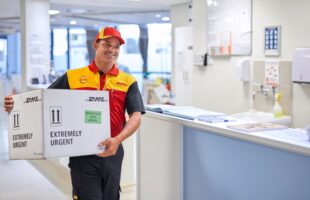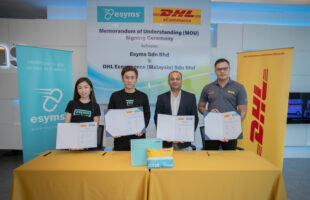The AF-KL-MP group’s recent unveiling to air cargo journalists of its brand spanking new €22 million HubExpress facility at Paris Charles De Gaulle Airport (CDG) in late May, clearly indicates the group still firmly believes in cargo, but just not the ‘old school’ version. While the carrier had insisted over a year ago in a press briefing in Amsterdam that it was redefining its cargo division to focus on higher yield products such as express and pharma, there has been little to show in the intervening period other than shedding maindeck capacity.
“This investment proves we attach a big importance to this activity and we strongly believe in the development of the express and postal business and this facility and that is why we have achieved a certain investment and dedicated so much energy to it,” said Air France Cargo EVP, Alain Malka. He adds that with AF-KLM’s extensive network with 450 daily flights through CDG alone, the new express offering “allows us to connect all over the world with multiple opportunities every day.”
The new express hub features an IT-driven, state-of-the-art sorting facility typical of the integrators’ setups, but virtually unheard of until now amongst the traditional mainline cargo carriers. The other page the carrier has torn from the integrators’ book, is airport-to-door delivery of express shipments anywhere in the world, which is offered on top of its airport-to-airport service.
This is accomplished utilising contract partners who do the clearance and ‘last mile’ delivery virtually anywhere in the world, according to Béatrice Delpuech, VP Express and Postal Solutions at Air France-KLM Cargo. In France this would be GeoPost but “in some places we are using DHL, or UPS, or FedEx or in the Middle East its Aramex and Bolloré in Africa – because those are the best for those areas,” she said.
“The idea is really to continue to work very intensively with integrators because they have always needed a little bit more capacity then what they have, so we are very close to the four big guys, so UPS with their Cologne hub are using us massively and with FedEx being in CDG is also a big partner for import and export and DHL is moving business from Asia to South America and into various places in Europe for transit business,” Delpuech says.
Aside from the integrators, she points to the courier companies as also being key customers, as too are postal companies “and of course being a carrier doing cargo for a long time our big customer is the forwarder who also needs an express product in order to bring their own solutions to their customer.”
Crucially, as Delpuech explains, “with FedEx we have a different kind of partnership, so either they buy line haul through quotation from us, or we are using FedEx for airport-to-door or they are using us airport-to-door.”
The air-to-air and air-to-ground express sorting facility was developed with partners SoDExl (Society of International Express Development) and GeoPost (a holding of the French Le Groupe La Poste). Financing was split in equal thirds – SoDExl, GeoPost and bank financing. SoDExl itself is a company jointly owned by Air France (65 per cent) and GeoPost (35 per cent).
Although not directly facing the apron, the new facility is only 5-15 minutes from the passenger aircraft parking stands with the express cargo trucked to the facility. As SoDExl CEO Jérôme Balbi put it, “we want to compete against Frankfurt and London in competition for transit shipments in Europe, but also Dubai and probably later Istanbul because we have strong competitors rising in front of us and really the goal is to save the time on the ground meaning that if we take six hours on the ground to transit shipment from one aircraft to another, it’s already the time you need to fly to Dubai.”
“We cannot fight against Emirates capacity and we cannot fight, as a European country, against the working regulations that might be easier in some other parts of the world. But the point on which we can compete, is technology and IT systems,” Balbi says.
“Behind the big sorter is a very big IT system and this whole system is controlled by it,” he said going on to explain that via the IT system, when a parcel enters the express system the next available flight and all subsequent connections are immediately calculated to make sure it will connect with the flights. “So for instance a parcel collected into Hong Kong at say 8PM in the evening can catch the 11PM flight to CDG, arrive at 6AM, connect to anywhere in Europe and we can deliver before noon – that’s quite a performance.”
Aiming to be the preferred gateway into Europe for express cargo, Balbi added: “We want to invoke the widest range of solutions possible for the customer. So from China, or from Australia flying into Europe if the customer wants to deliver everywhere in Europe of course we offer the possibility to go through the air, but we also want to offer a solution through road for the last European leg because it can be cheaper.
“And also because we are able to do the customs clearance in France, CDG is a global entry point for all of Europe so that’s very important for us to get all the solutions possible to the customer and we can customise the solution for their needs.”
Eight injection points feed a 300-metre long parcel sorter that includes constant monitoring through a minimum of four compulsory bar code scan points and the extensive IT system also gives customers full visibility of their shipments.
The packages are automatically sorted into one of 41 container stands, 10 bulk stands and 19 standby stands at a rate of 6,000 parcels per hour. The system, designed and built by Fives Cinetics, can handle individual packages or postal bags weighing up to 32kg with maximum dimensions 130 x 90 x 80 cm.
Although declining to specify a time frame, Bram Graeber, EVP Air France KLM Martinair Cargo says a similar facility will be built at KLM’s hub at Schiphol, likely when the cargo facilities there are expanded sometime in the near future. He added that the current facilities there do cater to express functions but not with the same capabilities of the new CDG facility.
“The airport-to-airport remains the same, but now with the new facility at CDG we have more capability to have all kinds of interfacing ground networks. I think it’s an inspiring example for Schiphol given the need to reinvest in the new cargo building there. So the basic classical airline network service is the same, but here we go a step further and I think it’s a great improvement,” Graeber said.
The facility will eventually be opened up for use by fellow SkyTeam Cargo alliance members, although he noted the original business case was premised solely around AF KLM Martinair. He also noted that it’s more complex to connect these the SkyTeam member airline systems than what the AF KLM Martinair group is doing with its own systems, but that SkyTeam has an existing system used on the passenger side, or ‘data pipe’ as he refers to it, that will be tested to see if its compatible for express cargo purposes.
“Later this year we will start by testing more intensive interlining of packages because the real added value of course is not to handle it in some warehouse, but to make the connections at the network points,” Graeber said.
For more on this story please read the June issue of Payload Asia.









